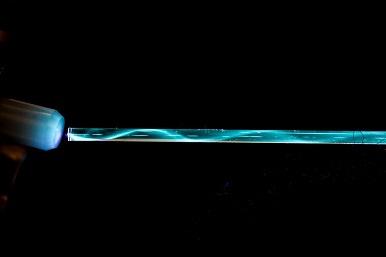Spetroscopy of oxides, nanostructures and glasses for optical technology and ionizing radiation detection

Our research focuses on the physical properties of luminescent materials for applications in photonics, optolectronics and ionizing radiation detection. Bulk materials, films and fibers are synthesized and studied, with particular interest for their specific optical properties obtained and controlled by doping with active ions and crystalline nanophases. Key aspects of these studies involve rare-earth ion spectroscopy, characterization of point defects, and wide-gap nanostructures in optical hosts. Synthesis techniques have been optimized to achieve good dispersion of active ions and crystalline nanoclusters in glass-based materials and scintillating optical fibers.
Materials for optical technology
Study of the light-emission and optical properties of wide-band-gap oxide nanostructures and light emitting species in glasses, crystals, and hybrid organic-inorganic materials, analyzing the applicability as light-emitting systems, sensors, photosensitive, and photocatalytic materials. Doped glass and glass-ceramics, as well as hybrid matrix, are technologically attractive in several areas, including optoelectronics, optical telecommunications, lighting technologies, sensors, photocatalysis, photovoltaic systems, and diagnostic tools.
Luminescent materials for ionizing radiation detection
Study of the optical properties of a broad range of luminescent materials for ionizing radiation detection (glasses, single crystals, ceramics, nanocomposites). We study luminescence and scintillation mechanisms, spanning from the interaction between the ionizing radiation and the material to the interplay between the luminescence centers (e.g. rare earth ions) and the host matrix, and the role of point defects on the scintillation performances. The aim of the research is the production and optimization of scintillating materials suitable for ionizing radiation detection applications in the industrial and medical fields, high-energy physics, and dosimetry.
Research Team
Prof. Mauro Fasoli
Prof. Roberto Lorenzi
Prof. Alberto Paleari
Dr. Francesca Cova
Research Lab
Optical Spectroscopy Laboratory - Building U5, Floor 1, Room 1100
Scintillation Laboratory - U5 Building, Floor 1, room 1105
Synthesis Laboratory - Building U5, Floor 1, room 1111
Facilities
- Optical Spectroscopy Laboratory: temperature-dependent optical absorption, temperature-dependent photoluminescence spectroscopy, temperature-dependent micro-Raman spectroscopy, refractive index measurements. Micro-ATR-FTIR analysis, time-resolved pulsed luminescence spectroscopy in the UV, visible and infrared.
- Scintillation laboratory: temperature-dependent radioluminescence spectroscopy, thermally stimulated and wavelength-resolved luminescence below and above room temperature, pulsed X-ray spectroscopy, thermally stimulated currents and X-ray fluorescence.
- Synthesis laboratory: sol gel preparation laboratory equipped with chemical and laminar flow hoods. Sintering furnaces in controlled atmosphere or vacuum. Saw and lapping machine for sample preparation with controlled and high-precision geometry.